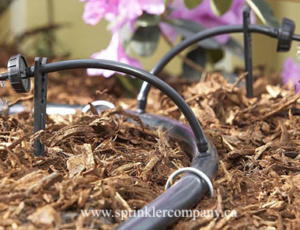Greenhouse Irrigation
– grown plants (and any plants, for that matter) cannot survive without some form of irrigation. While there are different types of greenhouse irrigation systems available – including sprinkler and subsurface systems – we use a drip irrigation system because of its efficiency and accuracy. Let’s take a closer look at how our drip irrigation system works and what informs our crop irrigation strategy!
What is Drip Irrigation?
Drip irrigation is exactly what it sounds like – irrigation administered to a crop through dripper technology. Every plant gets its own dripper tube. This tube is typically placed in the back corner of the substrate block in which our plants sit. It is also important to ensure the dripper is not pushed in too deep into the block. This makes it easier for the plant’s roots to access the nutrient water.
Drip irrigation is an efficient way to irrigate greenhouse crops – the placement of our dripper tubes makes it easy for our Growers to deliver precise volumes of nutrient water directly to the root systems of our plants.
Our drip irrigation process uses a pressure-compensated drip tube system that releases a specified volume of water once x amount of water pressure is applied to the dripper’s release valve. This allows for water and nutrients to be evenly distributed across our entire crop.
With greater efficiency and precision than other irrigation systems, establishing a drip irrigation strategy made the most sense for us. After all, as a commercial-sized greenhouse operation, we have hundreds of thousands of plants to irrigate every single day!
The Greenhouse Irrigation Strategy
When determining an irrigation strategy, our Growers have many factors to consider, including seasonal temperatures, light levels, crop development stages, and dry-down levels.
If you have any questions, our company provides a free assessment/consultation with our representative.

